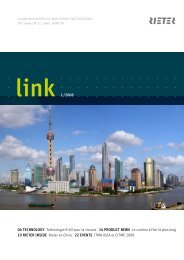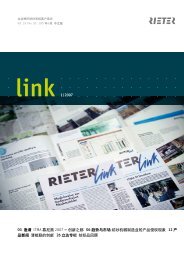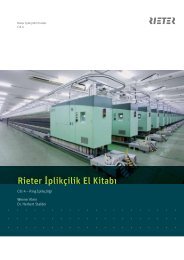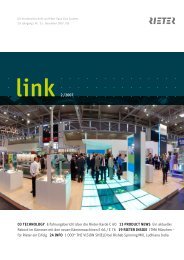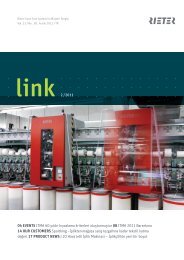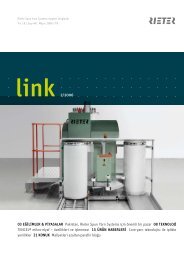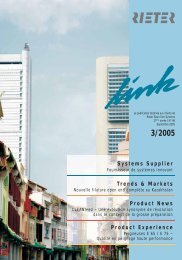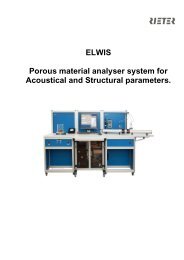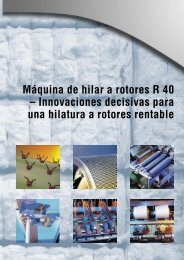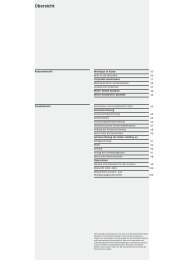Cover Story ACOusTiCs - Rieter
Cover Story ACOusTiCs - Rieter
Cover Story ACOusTiCs - Rieter
You also want an ePaper? Increase the reach of your titles
YUMPU automatically turns print PDFs into web optimized ePapers that Google loves.
<strong>Cover</strong> story <strong>ACOusTiCs</strong><br />
InnovatIve concepts<br />
for thermo-acoustic engine<br />
compartment encapsulation<br />
There is a clear trend towards retaining heat in the engine compartment for as long as possible in order to benefit<br />
fuel consumption. At the same, it is becoming increasingly difficult to achieve a quiet and pleasant exterior<br />
noise, because more efficient combustion is usually noisier combustion. According to <strong>Rieter</strong> and Nissan, both<br />
problems can be solved with clever encapsulation that, at an acceptable cost, cuts CO 2 emissions by 2.5 g/km<br />
and reduces exterior noise by up to 5 dB(A).<br />
12
AuTHORs<br />
Dr. maurizio mantovani<br />
is Head of Acoustics and Thermal<br />
Management at <strong>Rieter</strong> Automotive<br />
systems in Winterthur (switzerland).<br />
Hermann De Ciutiis<br />
is Global Product Manager Engine<br />
Compartment at <strong>Rieter</strong> Automotive<br />
systems in Winterthur (switzerland).<br />
Pierre Daniere<br />
is Project Manager R&D Product<br />
Material and Processes at <strong>Rieter</strong><br />
Automotive systems in Winterthur<br />
(switzerland).<br />
yosHiHiro sHiraHasHi<br />
is a member of infiniti Product<br />
Development NVH (Japan).<br />
Contrasting requirements<br />
The need to further reduce the noise of the<br />
engine has always been in conflict with the<br />
requirements of thermal safety and the<br />
necessity to reduce weight and cost. This<br />
conflict could become even greater in<br />
future, since the engine compartment of<br />
future conventional and hybridised vehicles<br />
will need to be more enclosed than<br />
today. The main reasons for this are the<br />
tighter regulations envisaged for exterior<br />
noise, the ever-growing requirements for<br />
exterior and interior noise quality and new<br />
European CO 2 legislation, all of which<br />
result in higher mean effective pressures<br />
and therefore tend to make engines noisier.<br />
In addition, the aim is to store heat in the<br />
engine compartment for as long as possible<br />
in order to reduce fuel consumption<br />
after a cold start. A further objective is to<br />
optimise the aerodynamic flow in the<br />
engine compartment.<br />
The encapsulation of the engine compartment<br />
arises from the need to reduce<br />
exterior noise, which is regulated by law.<br />
Typically, it consists of components fixed<br />
to the body. One exception is the engine<br />
top cover, which is attached directly to<br />
the engine. Acoustic absorbers are applied<br />
to the hood, the bulkhead, the sides of the<br />
front beams and an undershield. Today,<br />
undershields are partially covered by an<br />
acoustic material or made of an intrinsically<br />
absorbing and at the same time<br />
structural fibre-based material. Another<br />
trend is engine-mounted acoustic insulation<br />
components, most typically on the oil<br />
Full Load Acceleration, 500 Hz+ Overall A-weighted SPL Improvement due to Treatment No. 1 and No. 2<br />
Variant No. 1 Improvement<br />
Variant No. 2 Improvement<br />
pan and in the area around the fuel injectors.<br />
The advantages of such components<br />
are that they treat noise directly at the<br />
source and have a reduced size and therefore<br />
weight. However, a challenge for<br />
materials in contact with the engine is<br />
that they are exposed to strong vibrations,<br />
high temperatures and aggressive chemicals.<br />
Furthermore, there is the difficulty<br />
linked with interfacing the shields with a<br />
very complex geometrical environment.<br />
reDuCing BotH FueL<br />
ConsumPtion anD eXterior noise<br />
Several studies [1] conducted by <strong>Rieter</strong><br />
have shown that efficient encapsulation<br />
can provide a reduction in CO 2 emissions<br />
by 2.5 g/km in the New European Driving<br />
Cycle (NEDC). At the same time, it was<br />
demonstrated that underbody panelling<br />
can make a significant contribution<br />
towards reducing drag [2].<br />
Both measures will be required in the<br />
future, as not only CO 2 but also noise<br />
emissions will be more strictly limited by<br />
EU legislation. Transport noise in the EU<br />
is to be reduced by up to 10 dB(A) by<br />
2020 [3] through improvements to vehicles<br />
and infrastructure. The ongoing introduction<br />
of the new exterior noise test<br />
method might account for about a 2<br />
dB(A) reduction in the reported noise values.<br />
However, there is still a lot to be<br />
done. Some OEMs expect that a further 3<br />
dB(A) reduction in vehicle noise emissions<br />
will be needed.<br />
2500 2750 3000 3250 n/rpm 3750 4000 4250 4500<br />
35 40 45 Speed km/h 50 55 60<br />
1 Average noise reduction for two different encapsulation approaches and exterior noise measurement of the<br />
powertrain (exhaust, tyre, intake masked) of the Nissan infiniti in the semi-anechoic room<br />
01i2010 Volume 112 13<br />
L/dB<br />
10<br />
8<br />
6<br />
4<br />
2<br />
0
<strong>Cover</strong> story <strong>ACOusTiCs</strong><br />
Temperature after 15 hours<br />
2 °C<br />
Engine block temperature after 15 hours.<br />
Insulation thickness: 20 mm<br />
0 20 30 40 50 60 70 80 90 100<br />
Several of the engine-based measures<br />
needed to improve fuel efficiency (such as<br />
higher injection pressure, direct petrol<br />
injection, downscaling to three or even<br />
two cylinders, turbocharging) also have a<br />
negative effect on the radiated noise. Tests<br />
on a vehicle with a 2 l petrol engine [4]<br />
show a potential of a maximum 1.5 dB<br />
reduction in exterior noise by optimising<br />
the existing body-mounted parts. In 2007,<br />
a system of engine-mounted parts weighing<br />
less than 2.5 kg was presented [5].<br />
The system provided reductions in radiated<br />
noise in the engine test bench of 3 to<br />
4 dB. Equipping parts of the engine airintake<br />
system with porous acoustic materials<br />
integrated into a double-shell panel<br />
provides significant improvements in the<br />
exterior noise quality of a diesel vehicle<br />
[6]. The most recent study conducted on<br />
a Nissan Infiniti with a 3.7 l V6 petrol<br />
engine shows that body-mounted engine<br />
encapsulation can reduce powertrain<br />
noise by 5 dB, 1. Overall, the studies<br />
conclude that a combination of material<br />
optimisation and body-mounted and<br />
engine-mounted elements will be needed<br />
to achieve the legal requirements for significant<br />
noise reduction.<br />
ConCePts For tHermo-aCoustiC<br />
engine enCaPsuLation<br />
Body-mounted encapsulation is made of<br />
components originating from acoustic<br />
treatment: the bonnet absorber, outer<br />
bulkhead and under-engine shield. New<br />
elements are the vertical elements along<br />
the front beams and connected to the<br />
% <strong>Cover</strong>age<br />
Temperature after 15 hours<br />
1 °C<br />
above-mentioned elements in order to<br />
form a tightly enclosed engine compartment.<br />
It is also necessary to use electrically<br />
actuated shutters or other appropriate<br />
front closing elements to limit heat<br />
and noise leakage through the radiator.<br />
The system must ensure an efficient flow<br />
of air through the radiator for optimum<br />
engine cooling during driving. It should<br />
also block the dissipation of warm air<br />
when the vehicle is parked. Since vibrations<br />
and operating temperatures are<br />
lower for body-mounted components,<br />
lightweight materials such as foams and<br />
felts can be used. On the other hand, the<br />
surface to be treated with thermo-acoustic<br />
materials is greater in comparison to the<br />
engine-mounted system and cost-effective<br />
development of the sealing system against<br />
the bonnet can be challenging. Several<br />
pass-throughs for the steering column,<br />
drive shafts, cables and other interfaces<br />
need to be integrated, allowing easy<br />
assembly.<br />
Engine-mounted encapsulation is<br />
smaller but is fixed to surfaces that are<br />
usually hot and exposed to more vibration<br />
than the body. This requires more<br />
stable materials with higher temperature<br />
resistance. The subdivision of the encapsulation<br />
into its elements must allow<br />
access to the powertrain for maintenance.<br />
In practice, it is not possible to<br />
cover 100 % of the powertrain surface.<br />
Some ancillaries such as the alternator or<br />
the fuel injectors need to be cooled by<br />
air. <strong>Cover</strong>age of 85 % is, however, the<br />
minimum needed to achieve effective<br />
thermal encapsulation.<br />
Engine block temperatures after 15 hours.<br />
Comparison of several levels of engine coverage<br />
0 10 20 30 40 50<br />
60 % covered 70 % covered 80 % covered<br />
2 Temperature of the engine block after 15 hours of cooling, as a function of the thickness of the encapsulation (left) and of the area coverage (right)<br />
14<br />
Insulation thickness [mm]<br />
7 mm thick encapsulation covering<br />
80 % of the area is equivalent to 50 mm<br />
thick encapsulation covering only 60 %,<br />
2. Therefore, the first priority in the<br />
development of an encapsulation is the<br />
highest possible degree of area coverage<br />
rather than the choice of highly insulating<br />
materials.<br />
The potential of both approaches was<br />
evaluated in several vehicle tests, 3. It<br />
was shown that engine-mounted encapsulation<br />
has a slightly lower heat storage<br />
capacity, although one needs to consider<br />
that this design was more difficult to realise<br />
on the existing engine due to lack of<br />
space. In new engine developments, the<br />
possibility of increasing the area coverage<br />
and the average thickness of the insulating<br />
materials improves significantly.<br />
In the case of a body-mounted concept,<br />
it is usually easier to obtain sufficient area<br />
coverage, but the sealing of the system is<br />
more difficult. The weight of currently<br />
used systems for the thermal encapsulation<br />
of a four-cylinder engine is estimated<br />
at a maximum of 8 kg. For a B-segment<br />
car with a diesel engine, 6 °C higher powertrain<br />
temperatures in the NEDC translate<br />
into a CO 2 reduction of about 3 g/km,<br />
4. Considering the additional weight of<br />
the encapsulation, the actual CO 2 reduction<br />
can be calculated as 2.5 g/km. To<br />
achieve a comparable reduction by means<br />
of vehicle weight reduction, the weight<br />
would have to be reduced by 40 kg. The<br />
financial assessment of this advantage<br />
should also consider the new CO 2 limit<br />
values, which foresee monetary fines for<br />
fleets that exceed the limits.
One of the challenges in the implementation<br />
of thermo-acoustic encapsulation is<br />
the fulfilment of the thermal safety requirements<br />
under high load. This is in conflict<br />
with the wish to retain as much heat as<br />
possible when the vehicle is not in use. In<br />
body-mounted encapsulation, either the air<br />
coming from the radiator or the airflow<br />
from a special duct can be used to flush<br />
hot spots. If the encapsulation is also<br />
meant to provide improvements in aerodynamics,<br />
the airflow through the engine<br />
compartment should be minimised. A flow<br />
analysis of the engine compartment via<br />
CFD (computational fluid dynamics) and<br />
heat radiation computations show appropriate<br />
solutions in the concept phase.<br />
ComPonent arCHiteCture<br />
In order to maximise the benefit of the<br />
overall thermo-acoustic system, <strong>Rieter</strong> has<br />
focused in its product development on<br />
minimising weight and the interactions<br />
among components in the system. Packaging<br />
space is limited and assembly and<br />
service requirements further increase the<br />
complexity of the whole system.<br />
The Rie-BAY panel developed by <strong>Rieter</strong>,<br />
5, replaces several covers and the bonnet<br />
absorber by a single element, thus allowing<br />
a significant weight saving. Despite<br />
the full area coverage for heat storage and<br />
noise insulation, thanks to a new material<br />
based on temperature-resistant fibre-based<br />
materials, the solution leads to a weight<br />
advantage of about 50 % compared to<br />
injection-moulded parts, 6. The construction<br />
comprises a lower and an upper shell<br />
made of function-specific, structurally and<br />
acoustically optimised composite materials.<br />
The double-shell design efficiently<br />
combines the following:<br />
:<br />
:<br />
:<br />
:<br />
:<br />
high noise absorption<br />
high part stiffness<br />
heat insulation<br />
integration of cooling air ducts or<br />
engine air filtration and inlet<br />
integration of pedestrian protection<br />
absorbers, electric cables and devices.<br />
The requirements of the OEM with regard<br />
to haptics and optical appearance are fulfilled<br />
by the use of various foils or textile<br />
surfaces. Logos and colour surfaces can<br />
also be integrated into the upper shell. At<br />
the engine side, textile materials are used<br />
to obtain the required acoustic parameters.<br />
The use of heat-reflective foils outside or<br />
3 Overview of the thermal storage potential of different approaches to engine encapsulation<br />
inside the shells provides an additional 1<br />
°C of residual heat in the cool-down process.<br />
The component edges are designed in<br />
such a way that the sealing function<br />
towards the bonnet can be integrated in<br />
order to replace any heavy rubber seals.<br />
This results in another significant reduction<br />
in weight and assembly time. Design<br />
and quality control benefit from a leaner<br />
tolerance management with a single part<br />
when compared to the parts set used<br />
today. The patented double-shell principle<br />
also allows the compact integration of air<br />
ducts directly into the components. Further<br />
possible integrations could include electronics,<br />
electric cables and air filters. The<br />
CO [g/km]<br />
WeigHt inCrease to<br />
BaseLine veHiCLe<br />
temPerature<br />
inCrease to BaseLine<br />
veHiCLe aFter 12 H<br />
CooL-DoWn aFter<br />
Warm-uP<br />
Co 2 -reDuCtion During<br />
neDC oF 1.9L DieseL<br />
engine<br />
200<br />
195<br />
190<br />
185<br />
180<br />
175<br />
170<br />
165<br />
160<br />
155<br />
engine-mounteD<br />
enCaPsuLation<br />
ComBination oF<br />
engine-mounteD anD<br />
BoDy-mounteD<br />
enCaPsuLation<br />
4 CO 2 emissions as a function of the starting temperature in the NEDC<br />
Rie-BAY panel offers an almost package<br />
space neutral enhancement for heat and<br />
noise encapsulation, which can be used<br />
relatively independently of the engine variant<br />
installed in the car model. An additional<br />
engine top cover is eliminated by the<br />
proposed solution. Finally, the material<br />
concentration into one single module also<br />
improves end-of-life recycling.<br />
materiaLs For tHermaL anD<br />
aCoustiC insuLation in tHe<br />
engine ComPartment<br />
For engine-mounted parts such as engine<br />
covers or timing belt covers, injected PP or<br />
CO emissions during NEDC<br />
150<br />
-10 0 10 20 30 40 50 60 70<br />
Engine oil temperature at the beginning of NEDC [°C]<br />
Measurement on C-segment vehicle, 1.9 l diesel direct injection Extrapolation<br />
BoDy-mounteD<br />
enCaPsuLation<br />
4.7 – 5.2 kg 7.1 – 7.5 kg 4.2 – 4.7 kg<br />
6.6 9.4 6.1<br />
1.7 % 2.7 % 1.9 %<br />
tHermaL saFety –/ ° –/ ° °<br />
aCoustiC +/++ ++ +++<br />
01i2010 Volume 112 15
<strong>Cover</strong> story <strong>ACOusTiCs</strong><br />
5 Rie-BAY double-shell demonstration part (left) and construction (right)<br />
PA coupled with felt or PU foam-moulded<br />
absorbers are widely used. However, these<br />
material combinations are not suitable for<br />
a complete encapsulation due to their high<br />
weight (between 3 and 4 kg/m 2 ).<br />
Body-mounted acoustic parts are often<br />
made of glass wool or cotton felt, with<br />
phenolic resin as a binder, covered with<br />
treated nonwovens. Besides the good economics,<br />
these materials provide overall<br />
good flammability resistance. However,<br />
the resin has some disadvantages such as<br />
odour and VOC (volatile organic compounds)<br />
emissions.<br />
In recent years, <strong>Rieter</strong> has developed<br />
acoustic materials with sufficient mechanical<br />
resistance to be moulded into selfsupporting<br />
parts. One example is “KEST”<br />
from <strong>Rieter</strong>, a needled fibre material consisting<br />
of a combination of PP and a variable<br />
amount of glass fibres in order to balance<br />
acoustic and mechanical properties.<br />
However, such materials are not suited to<br />
the high temperatures close to an engine<br />
since they are limited to 140 °C (continuous<br />
engine surface temperature). There<br />
was therefore a need to develop materials<br />
that combine mechanical strength, acoustic<br />
effectiveness, heat insulation and heat<br />
stability.<br />
The frequency range of maximum<br />
acoustic absorption can also be adjusted<br />
thanks to the lamination of an acoustic<br />
resistive scrim (airflow resistance in the<br />
range of 1000 MKS rayls). To prevent fluid<br />
absorption into the fibres, to guarantee<br />
reFerenCe CHaraCteristiCs B-segment C-/D-segment e-segment<br />
stanDarD system<br />
6 Cost and weight comparison for four vehicle segments<br />
16<br />
toDay<br />
rie-Bay-PaneL<br />
Material Engine/<br />
Engine Bay <strong>Cover</strong>s<br />
PP-injection<br />
moulding<br />
PP- or PA-<br />
injection moulding<br />
PP- or<br />
PA-injection<br />
moulding<br />
(bi-color!)<br />
Number of parts 6 5 … 6 8<br />
Weight (kg) 1.5 2.2<br />
Material<br />
Rie-BAY-Panel<br />
HT-structural fibre HT-structural fibre<br />
6.3<br />
incl. air inlet<br />
HT-structural fibre<br />
+ sealing parts +<br />
air inlet<br />
Number of parts 1 1 1<br />
Weight (kg)<br />
Cost reduction<br />
potential<br />
0.7<br />
(–53 %)<br />
1.5 … 1.8<br />
–21 % … 33 %<br />
4.1<br />
(–36 %)<br />
+++ + … ++ +<br />
Rem.: Integration of sealing function (replacement EPDM-seals) not included in B- and D-segment.<br />
flammability compliance (Vertical UL94<br />
V0) and to provide acceptable aesthetic<br />
appearance, a proper choice of surface<br />
layers such as nonwovens or films is<br />
important.<br />
aCoustiC oPtimisation<br />
While lightweight materials often provide<br />
the necessary thermal insulation, the optimisation<br />
of their acoustic properties<br />
requires deeper consideration. If, for example,<br />
a high acoustic transmission loss is<br />
required for the encapsulation, heavy<br />
materials are often used, thus largely cancelling<br />
out the CO 2 reduction. <strong>Rieter</strong> used a<br />
REVAMP-SEA model of the engine compartment<br />
to examine two different material<br />
families. The first material family is based<br />
on the acoustic mass-spring concept (solid<br />
layer plus foam) while the second is based<br />
on the combination of a highly porous<br />
layer with low airflow resistance and a<br />
compressed porous layer with a high airflow<br />
resistance. The latter was developed<br />
and patented by <strong>Rieter</strong> under the brand<br />
name “<strong>Rieter</strong> Ultra Light”.<br />
7 shows that the engine-mounted<br />
encapsulation with the lightweight<br />
absorbing-insulating material provides a<br />
greater noise reduction to the engine compartment<br />
than the heavier mass-spring<br />
solution, based on a realistic area coverage<br />
of 80 %.<br />
The lightweight thermo-acoustic materials<br />
are easily mouldable for producing<br />
self-supporting parts with a stable shape<br />
and stable mechanical properties. At the
7 Engine compartment sound pressure level reduction due to engine-mounted encapsulation as a function of the area coverage<br />
same time, they are thick enough to guarantee<br />
acoustic and thermal insulation.<br />
The local wall thickness and density<br />
must be adjustable to comply with the<br />
available space and, according to the characteristics<br />
of the emitting noise sources,<br />
must provide a balance between acoustic<br />
absorption, insulation and heat insulation.<br />
The area weight of the entire concept,<br />
which integrates the acoustic and thermal<br />
insulation functions, is less than 2.5 kg/m 2 .<br />
Therefore, they allow the design of selfsupporting<br />
parts that are able to cover<br />
large surfaces.<br />
ConCLusions<br />
It is foreseeable that the internal combustion<br />
engines of future vehicles will require<br />
closed encapsulations in order to improve<br />
fuel efficiency and reduce exterior noise.<br />
This poses tremendous challenges for car<br />
manufacturers in terms of added complexity,<br />
weight, cost and thermal safety<br />
problems.<br />
The adoption of innovative system and<br />
component architectures, as shown by the<br />
Rie-BAY panel from <strong>Rieter</strong>, can achieve<br />
almost complete encapsulation. The CO 2<br />
reduction of 2.5 g/km is significant. What<br />
is more, advanced internal combustion<br />
engine concepts will be perceived by the<br />
end customer as being quieter.<br />
reFerenCes<br />
[1] de Ciutiis, H.; Bürgin, T.; Gorlato, L.: Auswirkungen<br />
von verschiedenen Motorraumkapsel-<br />
Konzepten auf Emissionen, Verbrauch und auf die<br />
thermische Betriebssicherheit im Motorraum eines<br />
Pkws. in: Wärmemanagement des Kraftfahrzeugs.<br />
Expert Verlag, Renningen, 2006<br />
[2] Lehmann, D.: Engineering Process for an<br />
innovative underfloor Module. <strong>Rieter</strong> Automotive<br />
Conference, Zürich, 2003<br />
[3] strategic Research Agenda of the European<br />
Road Transport Research Advisory Council,<br />
Dezember 2004<br />
[4] Mantovani, M.; Lehmann, D.: Functional and<br />
Material Acoustic Optimization integrated into<br />
underbody systems for Vehicle Performance<br />
improvement. sAE Paper 2007-01-2350<br />
[5] Meschke, J.; Gaudino, C.; Bendell, E.: Design<br />
and Optimization of an Engine-Mounted Thermal-<br />
Acoustical Encapsulation. <strong>Rieter</strong> Automotive<br />
Conference, Zürich 2007<br />
[6] Viktorovitch, M.: Acoustics of a Modular<br />
Engine Bay Encapsulation integrating a Porous Air<br />
intake system. <strong>Rieter</strong> Automotive Conference,<br />
Zürich 2007<br />
special thanks go to Youhei Kumagai (mem-<br />
ber of the infiniti Vehicle Engineering depart-<br />
ment of the Advanced Vehicle Dynamic<br />
Performance Development Group) and Dirk<br />
Lehmann (formerly Global Product Manager<br />
underbody and Engine Bay at <strong>Rieter</strong> Auto-<br />
motive systems) for their valuable contribu-<br />
tions to this article.<br />
thanks<br />
01i2010 Volume 112 17



